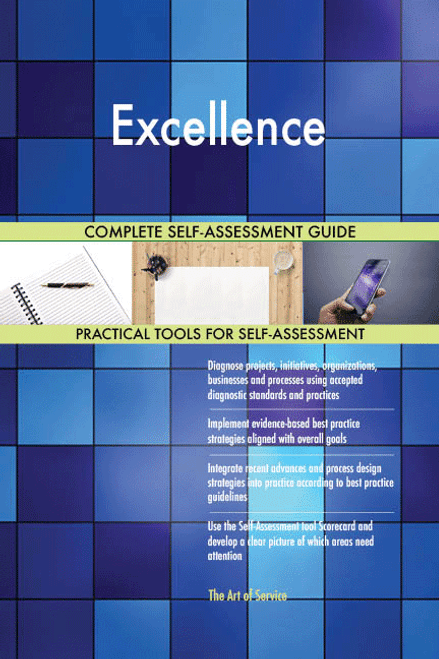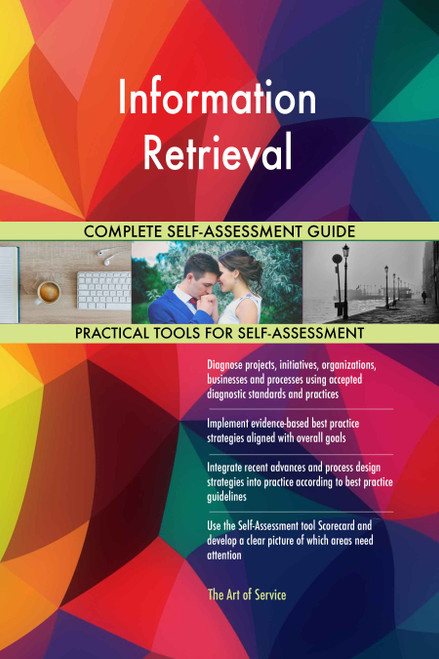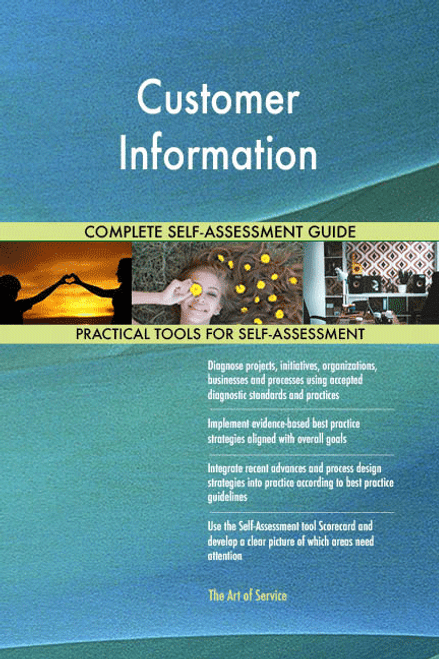Guide Information Excellence: effectively manage relationships with all internal and external stakeholders; develop and maintain superior processes for integrating external supplier ideas into thE Business.
More Uses of the Information Excellence Toolkit:
- Secure that your team advises business and Technology Teams concerning Information security risks and Compensating Controls that balance risk with project implementation.
- Maintain complete records of packaging process and equipment design activities, Test Data, and other pertinent information for each project.
- Confirm your venture maintains and utilizes netWork Management applications to identify network faults, to ensure the provision of data or other telecommunications access to customers, and the movement of information from one location to the other.
- Ensure your project applies Data Domain knowledge to your organization, channel, and application and process to satisfy regulatory and internal requirements related to Information Governance and Data Management.
- Be accountable for escalating unique issues or inaccurate information contained in Knowledge Base to the immediate supervisor for resolution.
- Analyze audit Security Incident logs for individual or multiple Network Devices for unauthorized information and processes and unauthorized Network Access.
- Coordinate response to Information security incidents, work with delivery team and client to identify Corrective Actions and take to closure.
- Analyze market data, shipper opportunities and competitive information to build and execute your organization Development Plan.
- Be certain that your organization uses mitigation, preparedness, and Response And Recovery approaches, to maximize safety, preservation of property, and Information security.
- Confirm your organization ensures that demographic information is entered into the system correctly by demonstrating accuracy and thoroughness.
- Confirm your venture develops and implements long term IT Strategy for your organization to maintain a Secure Environment, facilitate Service Delivery, ensure Business Continuity, and control costs.
- Ensure you guide; lead Strategic Planning efforts for thE Business Units Information Technology department, ensuring that IT programs and initiatives align to enterprise objectives and strategies.
- Be accountable for maintaining Call Center database by entering information and documenting customer interaction.
- Confirm your organization develops, review, and communicates Information security Risk Management Policies and Procedures to ensure appropriateness and adequacy versus industry Best Practices and Regulatory Requirements.
- Be certain that your organization uses information obtained in analysis to create program or solution that meets the need of customer.
- Establish Information Excellence: operator to effectively and efficiently manage across the account Operating model to optimize performance and client results.
- Manage Systems And Processes that protect information assets and systems against issues that could impact the confidentiality, integrity, and availability of information.
- Provide information Security Metrics and Key Performance Indicators (KPIs).
- Be accountable for participating in the development and management of datacenter Information Technology and Enterprise Architecture plans, policies or processes.
- Ensure a complete, accurate, and valid inventory of all systems, infrastructure, and applications that should be logged by the Security Information And Event Management (SIEM).
- Supervise Information Excellence: information technology specialization (network/Information security).
- Establish that your strategy provides guidance to Business Partners about applicability of Information security to meet Business Needs.
- Confirm your organization ensures that information is current as possible on the Geographic Information System information website.
- Determine the Information security approach and Operating model in consultation with departments and aligned with the Risk Management approach and Compliance Monitoring of non digital risk areas.
- Direct Information Excellence: conduct research of regulatory issues and information and dissemination of regulatory information to all levels of your organization.
- Confirm your organization leads the design, implementation, Operation And Maintenance of the Information security Management System based on applicable and current Information security Frameworks.
- Analyze performance data to provide Capacity Planning and Resource Utilization information in support of operational processes.
- Make sure that your corporation identifies, monitors and evaluates operational solutions to reduce Information security risk, meet Compliance Requirements and increase enterprise workforce efficiency, Business Agility and workforce scalability.
- Orchestrate Information Excellence: work closely with Information Technology (IT), Engineering, Security, Loss Prevention, Safety, Facilities, Supply Chain, Finance, Human Resources, Vendors, General Contractors, Operations, and the Project Team.
- Confirm your organization presents information about PKI service offerings reflecting your organizations capability and leveraging business Development Skills to support client needs.
- Ensure the robotic Process Flows are aligned to the robotics Center Of Excellence established operational model, governance, Development and Testing standards and Deployment Model.
- Oversee Information Excellence: own and lead the Data Center ssd Product Marketing efforts on the front end while working closely with technical marketing and product Development Teams on the Back End.
Save time, empower your teams and effectively upgrade your processes with access to this practical Information Excellence Toolkit and guide. Address common challenges with best-practice templates, step-by-step Work Plans and maturity diagnostics for any Information Excellence related project.
Download the Toolkit and in Three Steps you will be guided from idea to implementation results.
The Toolkit contains the following practical and powerful enablers with new and updated Information Excellence specific requirements:
STEP 1: Get your bearings
Start with...
- The latest quick edition of the Information Excellence Self Assessment book in PDF containing 49 requirements to perform a quickscan, get an overview and share with stakeholders.
Organized in a Data Driven improvement cycle RDMAICS (Recognize, Define, Measure, Analyze, Improve, Control and Sustain), check the…
- Example pre-filled Self-Assessment Excel Dashboard to get familiar with results generation
Then find your goals...
STEP 2: Set concrete goals, tasks, dates and numbers you can track
Featuring 999 new and updated case-based questions, organized into seven core areas of Process Design, this Self-Assessment will help you identify areas in which Information Excellence improvements can be made.
Examples; 10 of the 999 standard requirements:
- Can the solution be designed and implemented within an acceptable time period?
- How do you catch Information Excellence definition inconsistencies?
- Do Quality Systems drive continuous improvement?
- What Process Improvements will be needed?
- How much contingency will be available in the budget?
- What tools and technologies are needed for a custom Information Excellence project?
- Will Information Excellence have an impact on current Business Continuity, Disaster Recovery processes and/or infrastructure?
- What are the personnel training and qualifications required?
- Who is on the team?
- Explorations of the frontiers of Information Excellence will help you build influence, improve Information Excellence, optimize Decision Making, and sustain change, what is your approach?
Complete the self assessment, on your own or with a team in a workshop setting. Use the workbook together with the self assessment requirements spreadsheet:
- The workbook is the latest in-depth complete edition of the Information Excellence book in PDF containing 994 requirements, which criteria correspond to the criteria in...
Your Information Excellence self-assessment dashboard which gives you your dynamically prioritized projects-ready tool and shows your organization exactly what to do next:
- The Self-Assessment Excel Dashboard; with the Information Excellence Self-Assessment and Scorecard you will develop a clear picture of which Information Excellence areas need attention, which requirements you should focus on and who will be responsible for them:
- Shows your organization instant insight in areas for improvement: Auto generates reports, radar chart for maturity assessment, insights per process and participant and bespoke, ready to use, RACI Matrix
- Gives you a professional Dashboard to guide and perform a thorough Information Excellence Self-Assessment
- Is secure: Ensures offline Data Protection of your Self-Assessment results
- Dynamically prioritized projects-ready RACI Matrix shows your organization exactly what to do next:
STEP 3: Implement, Track, follow up and revise strategy
The outcomes of STEP 2, the self assessment, are the inputs for STEP 3; Start and manage Information Excellence projects with the 62 implementation resources:
- 62 step-by-step Information Excellence Project Management Form Templates covering over 1500 Information Excellence project requirements and success criteria:
Examples; 10 of the check box criteria:
- Cost Management Plan: Eac -estimate at completion, what is the total job expected to cost?
- Activity Cost Estimates: In which phase of the Acquisition Process cycle does source qualifications reside?
- Project Scope Statement: Will all Information Excellence project issues be unconditionally tracked through the Issue Resolution process?
- Closing Process Group: Did the Information Excellence Project Team have enough people to execute the Information Excellence Project Plan?
- Source Selection Criteria: What are the guidelines regarding award without considerations?
- Scope Management Plan: Are Corrective Actions taken when actual results are substantially different from detailed Information Excellence Project Plan (variances)?
- Initiating Process Group: During which stage of Risk planning are risks prioritized based on probability and impact?
- Cost Management Plan: Is your organization certified as a supplier, wholesaler, regular dealer, or manufacturer of corresponding products/supplies?
- Procurement Audit: Was a formal review of tenders received undertaken?
- Activity Cost Estimates: What procedures are put in place regarding bidding and cost comparisons, if any?
Step-by-step and complete Information Excellence Project Management Forms and Templates including check box criteria and templates.
1.0 Initiating Process Group:
- 1.1 Information Excellence project Charter
- 1.2 Stakeholder Register
- 1.3 Stakeholder Analysis Matrix
2.0 Planning Process Group:
- 2.1 Information Excellence Project Management Plan
- 2.2 Scope Management Plan
- 2.3 Requirements Management Plan
- 2.4 Requirements Documentation
- 2.5 Requirements Traceability Matrix
- 2.6 Information Excellence project Scope Statement
- 2.7 Assumption and Constraint Log
- 2.8 Work Breakdown Structure
- 2.9 WBS Dictionary
- 2.10 Schedule Management Plan
- 2.11 Activity List
- 2.12 Activity Attributes
- 2.13 Milestone List
- 2.14 Network Diagram
- 2.15 Activity Resource Requirements
- 2.16 Resource Breakdown Structure
- 2.17 Activity Duration Estimates
- 2.18 Duration Estimating Worksheet
- 2.19 Information Excellence project Schedule
- 2.20 Cost Management Plan
- 2.21 Activity Cost Estimates
- 2.22 Cost Estimating Worksheet
- 2.23 Cost Baseline
- 2.24 Quality Management Plan
- 2.25 Quality Metrics
- 2.26 Process Improvement Plan
- 2.27 Responsibility Assignment Matrix
- 2.28 Roles and Responsibilities
- 2.29 Human Resource Management Plan
- 2.30 Communications Management Plan
- 2.31 Risk Management Plan
- 2.32 Risk Register
- 2.33 Probability and Impact Assessment
- 2.34 Probability and Impact Matrix
- 2.35 Risk Data Sheet
- 2.36 Procurement Management Plan
- 2.37 Source Selection Criteria
- 2.38 Stakeholder Management Plan
- 2.39 Change Management Plan
3.0 Executing Process Group:
- 3.1 Team Member Status Report
- 3.2 Change Request
- 3.3 Change Log
- 3.4 Decision Log
- 3.5 Quality Audit
- 3.6 Team Directory
- 3.7 Team Operating Agreement
- 3.8 Team Performance Assessment
- 3.9 Team Member Performance Assessment
- 3.10 Issue Log
4.0 Monitoring and Controlling Process Group:
- 4.1 Information Excellence project Performance Report
- 4.2 Variance Analysis
- 4.3 Earned Value Status
- 4.4 Risk Audit
- 4.5 Contractor Status Report
- 4.6 Formal Acceptance
5.0 Closing Process Group:
- 5.1 Procurement Audit
- 5.2 Contract Close-Out
- 5.3 Information Excellence project or Phase Close-Out
- 5.4 Lessons Learned
Results
With this Three Step process you will have all the tools you need for any Information Excellence project with this in-depth Information Excellence Toolkit.
In using the Toolkit you will be better able to:
- Diagnose Information Excellence projects, initiatives, organizations, businesses and processes using accepted diagnostic standards and practices
- Implement evidence-based Best Practice strategies aligned with overall goals
- Integrate recent advances in Information Excellence and put Process Design strategies into practice according to Best Practice guidelines
Defining, designing, creating, and implementing a process to solve a business challenge or meet a business objective is the most valuable role; In EVERY company, organization and department.
Unless you are talking a one-time, single-use project within a business, there should be a process. Whether that process is managed and implemented by humans, AI, or a combination of the two, it needs to be designed by someone with a complex enough perspective to ask the right questions. Someone capable of asking the right questions and step back and say, 'What are we really trying to accomplish here? And is there a different way to look at it?'
This Toolkit empowers people to do just that - whether their title is entrepreneur, manager, consultant, (Vice-)President, CxO etc... - they are the people who rule the future. They are the person who asks the right questions to make Information Excellence investments work better.
This Information Excellence All-Inclusive Toolkit enables You to be that person.
Includes lifetime updates
Every self assessment comes with Lifetime Updates and Lifetime Free Updated Books. Lifetime Updates is an industry-first feature which allows you to receive verified self assessment updates, ensuring you always have the most accurate information at your fingertips.











